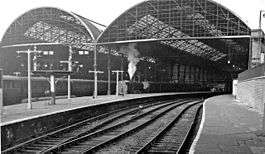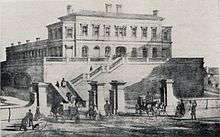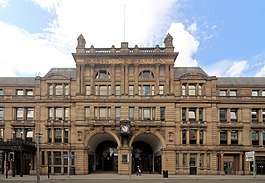Birkenhead Woodside railway station
Birkenhead Woodside was a railway station at Woodside, in Birkenhead, on the Wirral Peninsula, Cheshire.
| Birkenhead Woodside | |
|---|---|
 Birkenhead Woodside railway station in 1961 | |
| Location | |
| Place | Birkenhead |
| Area | Wirral |
| Grid reference | SJ328892 |
| Operations | |
| Original company | Chester and Birkenhead Railway |
| Pre-grouping | GWR & LNWR Joint[1] |
| Platforms | Five |
| History | |
| Key dates | Opened 31 March 1878 Closed 5 November 1967[2] |
| Disused railway stations in the United Kingdom | |
| Closed railway stations in Britain A B C D–F G H–J K–L M–O P–R S T–V W–Z | |
Background
Birkenhead Woodside railway station was opened on 31 March 1878 to replace the increasingly inadequate passenger facilities provided at Birkenhead Monks Ferry station.[3][4] The terminus was built further inland than originally conceived, in order to avoid demolition of the Mersey ferries workshop, situated on the bank of the river. The station was built on an east–west axis with the lines servicing the station coming from the south. The station was accessed via a half mile tunnel from the south which curved to the east into the station. This fell in line with the Liverpool termini, with only Liverpool Exchange lacking tunnel access.[5]
In order to join up with the existing track of the Chester and Birkenhead Railway, the half mile-long tunnel from Woodside to alongside the existing Monks Ferry tunnel entrance, near Grange Lane, was constructed using the cut-and-cover method, with most of its length running under Chester Street.[6]
The station was cramped, with Platform 1 being 537 ft (164 m) in length, and longer coaching stock was not allowed to be stabled on the curved part of No.3 siding.[7]
Building

The station was a grandiose building, with two semi cylindrical roofs covering much of the platforms. However, the size of the station made it have only five short (but wide) platforms, as much of the space was taken up by middle tracks and a roadway.[3]
The station building was known to local rail users as "the wrong way round"; for the majority of the station's life, its original rear entrance was used as the main booking hall, and Woodside's 'front' entrance was mainly for handling parcels. The lattee entrance, covered in a porte-cochere to allow travelling gentry to avoid inclement weather, faced the graving dock on the south side of the station. It had been intended that passengers disembarking from the nearby ferry terminal of the same name would use this entrance. Unfortunately, the ferry companies were slow at co-operating and when the tram terminus opened in front of the ferry terminal in the early 1900s, the decision was made to keep the small 'back' entrance a permanent fixture. That was very unfortunate, as passengers arriving at the station never got to see the huge sandstone fireplaces, decorative brick work and massive timber roof trusses holding up the roof of the intended booking hall, which has been described by Marcus Binney of SAVE Britain's Heritage as "a station of truly baronial proportions and being worthy of any London terminus".
Services
Birkenhead Woodside was the terminus for local services to Chester, Helsby, West Kirby, and destinations in North Wales via Ruabon.[4] Routes further afield included Great Western Railway (GWR) services to Chester General, Wrexham General, Shrewsbury, Wolverhampton Low Level, Birmingham Snow Hill, and London Paddington. There were also daily through trains to the Kent coast via Oxford, Reading and Redhill run jointly with the Southern Railway whose green liveried stock was to be seen at Woodside on alternate days, and summer services to Bournemouth.
Closure
The Beeching Report, in 1963, recommended the closure of three of Merseyide's mainline terminal stations: Liverpool Exchange, Liverpool Central High Level and Birkenhead Woodside. It also recommend the closure of the Liverpool Exchange to Southport electric commuter route and of all routes in to Central High Level station. However, the electric lines from Liverpool to the Wirral were recommended for retention. Long- and medium- distance routes served by the three termini were to be concentrated on Lime Street station.[4]
Liverpool City Council viewed matters differently from Beeching by proposing the retention of the suburban services around the city and their integration into a regional Merseyside-wide rapid-transit network. That approach was supported by the Merseyside Area Land Use and Transportation Study, the MALTS report. Liverpool City Council's proposal was adopted and Merseyrail was born.[8]
- Lime Street station, in Liverpool city centre was to remain, absorbing the long- and medium-distance passenger traffic of the closed terminal stations.
- The local urban services served by the terminal stations would be absorbed by the new Merseyrail urban network.[4]
By early 1967, there were still six through trains on weekdays between Birkenhead Woodside and London Paddington. In March of that year, the route was effectively curtailed at Wolverhampton, as a result of the introduction of electric trains on the West Coast Main Line.[9] At the same time, the last steam service from the station took place, in the withdrawal of through services to Birmingham.[9]
Only the diesel train service to Chester and trains to Helsby remained to use the station. The station closed to passengers on 5 November 1967[2] and was demolished within a couple of years. The Chester and Helsby route was cut back to Rock Ferry after the station's closure. In 1993, the Chester line was electrified and incorporated into Merseyrail;[10] the branch from Hooton to Helsby was electrified as far as Ellesmere Port a year later and also incorporated into Merseyrail.
Today, the only evidence of Woodside's existence is a part of the station wall, a road bridge and the tunnel, which lay at the station throat. The gates of the station were reused at a house in Gayton.[4] The rest of the land is now used as a bus park and the Woodside Business Park. The half-mile tunnel access to the site is not impeded and so there is provision for future modes of transport.
Association with Wilfred Owen
Thomas (known as Tom) Owen, the father of First World War poet Wilfred Owen, was Stationmaster at Woodside from 1898[11] until moving back to Shropshire (from where he had moved to Birkenhead) to take up a senior post at Shrewsbury railway station in 1907.[12] During that period the family lived at three successive homes in the Tranmere district[13] and Wilfred attended the Birkenhead Institute High School (since demolished) for his education.
See also
References
- Welbourn 2003, p. 84
- Hendry & Hendry 1992, p. 119
- Maund 2000, p. 40
- "Disused Stations: Birkenhead Woodside". Disused Stations. Retrieved 31 August 2016.
- Maund 2000
- Maund 2000, p. 39
- Hendry & Hendry 1992, p. 118
- City Centre Planning Group 1965
- Maund 2000, p. 74
- Maund 2000, p. 77
- Stallworthy 1974, p. 13
- Stallworthy 1974, pp. 35–36
- Stallworthy 1974, pp. 13–14
Sources
- City Centre Planning Group (1965). Liverpool City Centre Plan. City and County Borough of Liverpool. ASIN B003KVB92O. OCLC 8321490.CS1 maint: ref=harv (link)
- Hendry, R. Preston; Hendry, R. Powell (1992). Paddington to the Mersey. Oxford Publishing Company. ISBN 9780860934424. OCLC 877729237.CS1 maint: ref=harv (link)
- Maund, T.B. (2000). The Birkenhead Railway. The Railway Correspondence & Travel Society. ISBN 0-901115-87-8. OCLC 49815012.CS1 maint: ref=harv (link)
- Stallworthy, Jon (1974). Wilfred Owen, A Biography. Oxford University Press and Chatto and Windus. ISBN 0-19-211719X.CS1 maint: ref=harv (link)
- Welbourn, Nigel (2003) [First published 1994]. Lost Lines: LMR. Ian Allan. ISBN 9780711022775. OCLC 863421456.CS1 maint: ref=harv (link)
Further reading
- Merseyside Railway History Group (1994). Railway Stations of Wirral. ISBN 1-899241-02-7.
- Mitchell, Vic; Smith, Keith (2012). Chester to Birkenhead. Middleton Press. figs. 89-94. ISBN 9781908174215. OCLC 811323335.
External links
- Signalling Record Society - Track and signalling diagram of Birkenhead Woodside station
- Wirral Transport Museum website
| Preceding station | Historical railways | Following station | ||
|---|---|---|---|---|
| Birkenhead Town Line and station closed |
GWR & LNWR Chester & Birkenhead Railway |
Terminus | ||


.jpg)